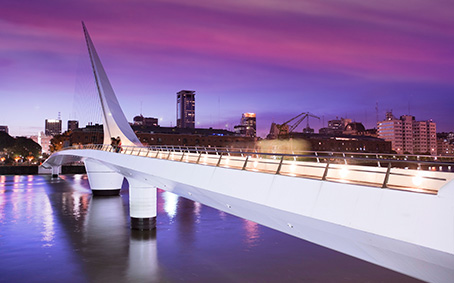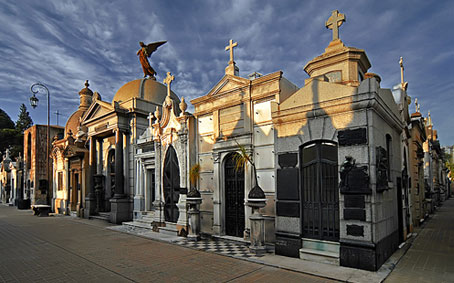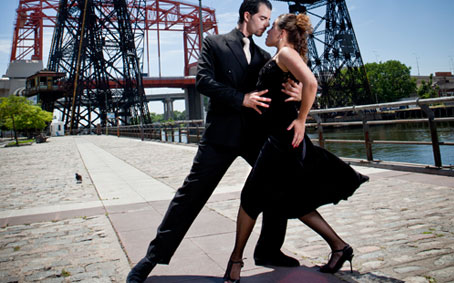


Argentina. Buenos aires
BUENOS AIRES WALKING TOUR
Historical Buenos Aires walking tours available:
1) Puerto Madero:
The goal of this tour is to show how, like it has happened in many great capitals of the world, maybe in London more than in any other, an abandoned area can become the city’s most select neighborhood with an exclusive marina, and a modern cultural, hotel and restaurant district. Our visit kicks off at the Buquebús Ferry Terminal. Considering its old warehouse wasn’t recycled back in the 1990s, we’ll get a chance to see how the area looked before the renovations started. Next, we walk down Alicia Moreau de Justo Avenue, were we see the sharp contrast between the refurbished warehouses, of English industrial style, the state-of-the-art Inclán Building (designed by César Pelli), the Fortabat Tower and the Diario La Nación Building (both by the SEPRA buffet), and buildings from the early 20th century, such as the Central Post Office, the old Customs Building and the Ministry of Defense. Next, we visit the Sarmiento Frigate. This ship houses a museum, where we’ll see how a 19th century frigate actually operated. Then, we head for Madero Este crossing the Puente de la Mujer (Woman’s Bridge), designed by Spanish genius Santiago Calatrava. Once there, we’ll realize everything looks very modern. Nevertheless, we’ll be able to notice the contrast between the Faena + Universe, designed by Phillippe Starck, which used to be a silo, and the Los Molinos Building, designed by the McCormack buffet, which used to be a mill. Our visit ends back on the other side of the building, where we’ll admire once again the contrast between the renovated old and the modern buildings.
2) Retiro and Recoleta
In the early 20th century, the Argentine aristocracy experienced an unprecedented prosperity; back then, Paris was the undisputed center of the world, and local aristocrats dreamed of competing with Paris, and of displaying their wealth on the city’s architecture, imitating the splendor of the French capital, in order to finally turn Buenos Aires into a global metropolis. Our starting point is the splendid Plaza San Martín, located in the heart of Buenos Aires. Around Plaza San Martín stand tall some of the city’s most conspicuous buildings. Some of them will allow us to imagine the splendid life the wealthier classes lived in the early 20th century: such is the case of the former Palacio Paz, which nowadays houses the Military Society, the Palacio Anchorena, that presently hosts the Ministry of Foreign Affaires, and the Palacio Haedo, which is used by the National Parks Administration. Then, we visit the monumental Retiro Railway Station, Academicist in style, opened in 1915. Although the design and materials came from Britain, it rivals in spirit with the traditional Parisian gares. Next, we walk across the elegant Arroyo Street –the word actually means ‘stream of water’, and it certainly honors the meandering course of this charming street. Besides its great architecture, Arroyo concentrates the most important art galleries in town. Finishing our tour, we walk down Alvear Avenue, a sort of smaller-scale Champs Elysées. There, we admire the sumptuous French-styled palaces, such as the Ortíz Basualdo Palace, nowadays the French Embassy, and the Pereda Palace, which now houses the Brazilian Embassy.
3) La Boca is arguably one of Buenos Aires’ most authentic neighborhoods. Away from the modernizing and internationalizing waves that have been shaking the city since the 1990s, this working class port district has been jealously guarding its identity, of which soccer and Tango are very important parts. The first that strikes the visitors about La Boca is its peculiar architecture. On one side, we find the typical houses made out of tin and scrape metal, painted with a wide array of colors. They were erected by immigrants, who used leftover materials and paint from the docks and nearby shipyards. On the other side, we see the famous tenement houses, were many families from the working class lived tightly crammed together. On of the neighborhood’s most recognizable icons is the Alberto J. Armando Stadium, nicknamed La Bombonera (The Chocolate Box), which is Boca Junior’s stadium, the country’s largest soccer team, and the one favored by Diego Maradona, probably one of the most famous people in the world. We also visit the emblematic Caminito Street, a true outdoor museum, dedicated to soccer and Tango. Finally, we enter the Quinquela Martín Museum, located in a building decorated and donated by the artist in 1933, to house an elementary school, an Argentine art museum and his own home and workshop. Here, we learn about his intense life and his strong social commitment.